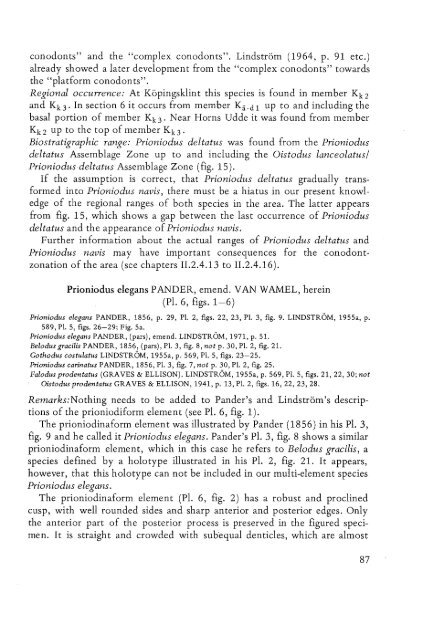UTRECHT MICROPALEONTOLOGICAL BUllETINS
UTRECHT MICROPALEONTOLOGICAL BUllETINS
UTRECHT MICROPALEONTOLOGICAL BUllETINS
You also want an ePaper? Increase the reach of your titles
YUMPU automatically turns print PDFs into web optimized ePapers that Google loves.
conodonts" and the "complex conodonts". Lindstrom (1964, p. 91 etc.)<br />
already showed a later development from the "complex conodonts" towards<br />
the "platform conodonts".<br />
Regional occurrence: At Kopingsklint this species is found in member K k 2<br />
and K k 3' In section 6 it occurs from member K ii - d 1 up to and including the<br />
basal portion of member K k3 . Near Horns Udde it was found from member<br />
K k2 up to the top of member K k3 .<br />
Biostratigraphic range: Prioniodus deltatus was found from the Prioniodus<br />
deltatus Assemblage Zone up to and including the Oistodus lanceolatus/<br />
Prioniodusdeltatus Assemblage Zone (fig. 15).<br />
If the assumption is correct, that Prioniodus deltatus gradually transformed<br />
into Prioniodus navis, there must be a hiatus in our present knowledge<br />
of the regional ranges of both species in the area. The latter appears<br />
from fig. 15, which shows a gap between the last occurrence of Prioniodus<br />
deltatus and the appearance of Prioniodus navis.<br />
Further information about the actual ranges of Prioniodus deltatus and<br />
Prioniodus navis may have important consequences for the conodontzonation<br />
of the area (see chapters 11.2.4.13 to 11.2.4.16).<br />
Prioniodus elegans PANDER, emend. VAN WAMEL, herein<br />
(PI. 6, figs. 1-6)<br />
Prioniodus elegans PANDER, 1856, p. 29, PI. 2, figs. 22, 23, PI. 3, fig. 9. LINDSTROM, 1955a, p.<br />
589, PI. 5, figs. 26-29; Fig. 5a.<br />
Prioniodus elegans PANDER, (pars), emend. LINDSTROM, 1971, p. 51.<br />
Belodus gracilis PANDER, 1856, (pars), PI. 3, fig. 8, not p. 30, PI. 2, fig. 21.<br />
Gothodus costulatus LINDSTROM, 1955a, p. 569, Pi. 5, figs. 23-25.<br />
Prioniodus carinatus PANDER, 1856, PI. 3, fig. 7, not p. 30, PI. 2, fig. 25.<br />
Falodus prodentatus (GRAVES & ELLISON). LINDSTROM, 1955a, p. 569, PI. 5, figs. 21, 22, 30; not<br />
Oistodusprodentatus GRAVES & ELLISON, 1941, p. 13, PI. 2, figs. 16, 22, 23,28.<br />
Remarks:Nothing needs to be added to Pander's and Lindstrom's descriptions<br />
of the prioniodiform element (see PI. 6, fig. 1).<br />
The prioniodinaform element was illustrated by Pander (1856) in his PI. 3,<br />
fig. 9 and he called it Prioniodus elegans. Pander's PI. 3, fig. 8 shows a similar<br />
prioniodinaform element, which in this case he refers to Belodus gracilis, a<br />
species defined by a holotype illustrated in his PI. 2, fig. 21. It appears,<br />
however, that this holotype can not be included in our multi-element species<br />
Prioniodus elegans.<br />
The prioniodinaform element (PI. 6, fig. 2) has a robust and proclined<br />
cusp, with well rounded sides and sharp anterior and posterior edges. Only<br />
the anterior part of the posterior process is preserved in the figured specimen.<br />
It is straight and crowded with subequal denticles, which are almost
















